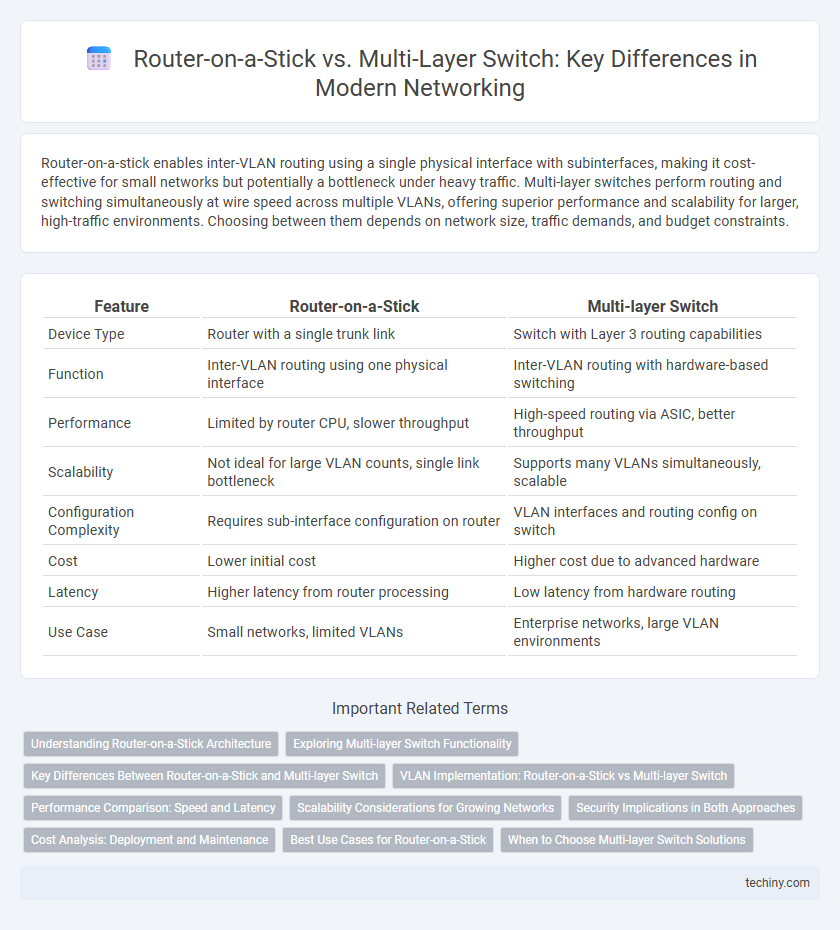Router-on-a-stick enables inter-VLAN routing using a single physical interface with subinterfaces, making it cost-effective for small networks but potentially a bottleneck under heavy traffic. Multi-layer switches perform routing and switching simultaneously at wire speed across multiple VLANs, offering superior performance and scalability for larger, high-traffic environments. Choosing between them depends on network size, traffic demands, and budget constraints.
Table of Comparison
| Feature | Router-on-a-Stick | Multi-layer Switch |
|---|---|---|
| Device Type | Router with a single trunk link | Switch with Layer 3 routing capabilities |
| Function | Inter-VLAN routing using one physical interface | Inter-VLAN routing with hardware-based switching |
| Performance | Limited by router CPU, slower throughput | High-speed routing via ASIC, better throughput |
| Scalability | Not ideal for large VLAN counts, single link bottleneck | Supports many VLANs simultaneously, scalable |
| Configuration Complexity | Requires sub-interface configuration on router | VLAN interfaces and routing config on switch |
| Cost | Lower initial cost | Higher cost due to advanced hardware |
| Latency | Higher latency from router processing | Low latency from hardware routing |
| Use Case | Small networks, limited VLANs | Enterprise networks, large VLAN environments |
Understanding Router-on-a-Stick Architecture
Router-on-a-stick architecture uses a single physical router interface to route traffic between multiple VLANs by configuring subinterfaces with unique VLAN IDs. This setup enables inter-VLAN routing on a limited hardware footprint but can introduce bottlenecks due to shared bandwidth on the single interface. In contrast, multi-layer switches perform routing at the switch level, offering higher performance and scalability for complex network environments.
Exploring Multi-layer Switch Functionality
Multi-layer switches combine hardware switching and routing functions to efficiently manage traffic within and between VLANs, reducing latency compared to router-on-a-stick configurations. These devices support advanced routing protocols like OSPF and EIGRP directly on the switch, enabling faster inter-VLAN communication without relying on a separate router interface. Multi-layer switches also offer enhanced security features and QoS capabilities, optimizing network performance and scalability in complex enterprise environments.
Key Differences Between Router-on-a-Stick and Multi-layer Switch
Router-on-a-stick utilizes a single physical interface on a router to route traffic between multiple VLANs through sub-interfaces, creating a bottleneck in high-traffic environments. Multi-layer switches perform routing functions at hardware level with distinct interfaces for each VLAN, enabling faster packet processing and supporting higher throughput. Key differences include scalability, performance, and deployment complexity, where multi-layer switches offer superior speed and efficiency for large networks compared to the more cost-effective but slower router-on-a-stick setup.
VLAN Implementation: Router-on-a-Stick vs Multi-layer Switch
Router-on-a-stick uses a single physical interface configured with sub-interfaces to route traffic between VLANs, resulting in potential bottlenecks due to limited bandwidth. Multi-layer switches perform inter-VLAN routing directly at the switch level with dedicated hardware, significantly enhancing throughput and reducing latency. VLAN implementation on multi-layer switches supports scalable, high-performance environments by integrating routing and switching functions efficiently.
Performance Comparison: Speed and Latency
Router-on-a-stick architecture introduces higher latency due to the single physical interface handling multiple VLANs through subinterfaces, causing increased processing delays and bandwidth limitations. Multi-layer switches operate at wire-speed with hardware-based switching and routing, offering significantly lower latency and higher throughput by processing packets within the switching ASICs. In high-traffic environments, multi-layer switches deliver superior performance, minimizing bottlenecks and optimizing network speed compared to the router-on-a-stick configuration.
Scalability Considerations for Growing Networks
Router-on-a-stick architecture can become a bottleneck as network traffic increases due to its reliance on a single physical interface for multiple VLANs, limiting scalability in growing networks. Multi-layer switches offer enhanced scalability by processing inter-VLAN routing directly at hardware speeds across multiple ports, which reduces latency and maximizes throughput. For expanding enterprise networks, multi-layer switches provide a more robust and efficient solution to handle increased traffic and complex segmentation demands.
Security Implications in Both Approaches
Router-on-a-stick enables inter-VLAN routing through a single physical interface using sub-interfaces, which can introduce a single point of failure and potential security vulnerabilities if the trunk link is compromised. Multi-layer switches provide hardware-based VLAN routing with integrated access control lists (ACLs) and segmentation, offering enhanced security by minimizing exposure to attacks and allowing more granular traffic filtering. The choice affects network attack surfaces, with multi-layer switches generally providing stronger isolation and reducing risks like VLAN hopping or spoofing compared to router-on-a-stick configurations.
Cost Analysis: Deployment and Maintenance
Router-on-a-stick setups typically incur lower initial deployment costs due to using a single physical router interface for multiple VLANs, reducing hardware expenses. Multi-layer switches have higher upfront investment but offer cost savings in maintenance with integrated routing capabilities and fewer devices to manage. Organizations must weigh the trade-off between affordable hardware and the efficiency gains from reduced complexity and maintenance overhead.
Best Use Cases for Router-on-a-Stick
Router-on-a-stick is best suited for small to medium-sized networks requiring inter-VLAN routing on a single physical interface, offering cost-effective segmentation without additional hardware. It excels in environments with limited port availability where VLAN traffic must be routed through a centralized router. This setup is ideal for branch offices or scenarios with lower traffic loads, where simplicity and budget constraints are prioritized over high throughput and scalability.
When to Choose Multi-layer Switch Solutions
Multi-layer switches offer superior performance for complex networks requiring high-speed inter-VLAN routing and extensive Layer 3 capabilities, supporting up to thousands of VLANs with low latency. They are ideal in enterprise environments with heavy traffic, needing advanced features like Quality of Service (QoS), multicast routing, and hardware-based packet forwarding. Choosing a multi-layer switch ensures scalability and efficient management in large, converged networks where router-on-a-stick limitations could cause bottlenecks.
Router-on-a-stick vs Multi-layer Switch Infographic

 techiny.com
techiny.com